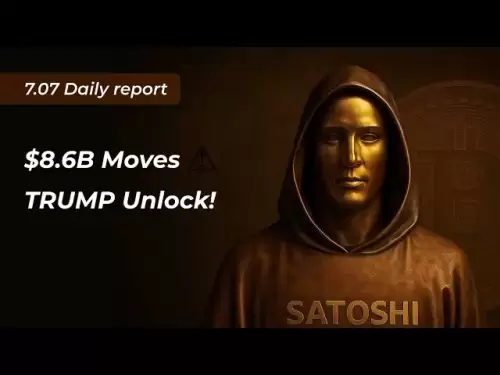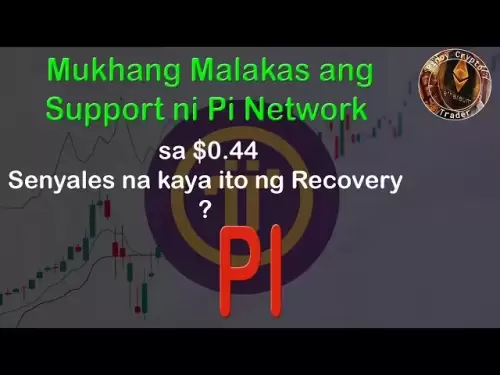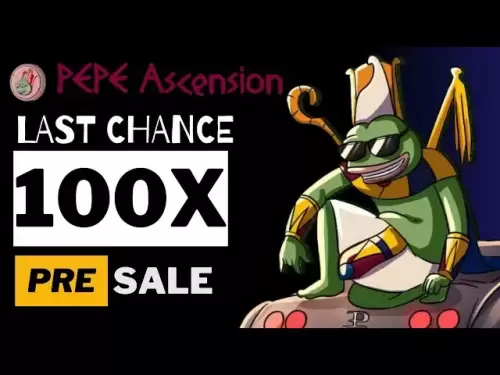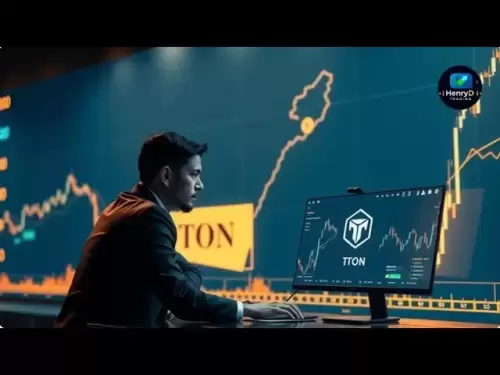-
 Bitcoin
Bitcoin $108,960.1513
0.84% -
 Ethereum
Ethereum $2,578.1548
2.56% -
 Tether USDt
Tether USDt $1.0001
-0.02% -
 XRP
XRP $2.2702
1.71% -
 BNB
BNB $662.6676
1.28% -
 Solana
Solana $152.6556
3.53% -
 USDC
USDC $0.9999
0.00% -
 TRON
TRON $0.2865
0.80% -
 Dogecoin
Dogecoin $0.1726
5.60% -
 Cardano
Cardano $0.5883
2.60% -
 Hyperliquid
Hyperliquid $39.9405
3.10% -
 Sui
Sui $2.9147
1.24% -
 Bitcoin Cash
Bitcoin Cash $493.8494
2.04% -
 Chainlink
Chainlink $13.6129
3.68% -
 UNUS SED LEO
UNUS SED LEO $9.0589
0.46% -
 Avalanche
Avalanche $18.2965
2.82% -
 Stellar
Stellar $0.2493
4.35% -
 Shiba Inu
Shiba Inu $0.0...01178
2.25% -
 Toncoin
Toncoin $2.8078
-6.81% -
 Hedera
Hedera $0.1604
4.96% -
 Litecoin
Litecoin $87.8270
1.20% -
 Monero
Monero $320.4173
1.87% -
 Polkadot
Polkadot $3.4079
1.81% -
 Dai
Dai $1.0000
0.00% -
 Ethena USDe
Ethena USDe $1.0000
-0.01% -
 Bitget Token
Bitget Token $4.4122
0.50% -
 Uniswap
Uniswap $7.3890
1.84% -
 Aave
Aave $286.0205
5.66% -
 Pepe
Pepe $0.0...01012
4.35% -
 Pi
Pi $0.4643
3.14%
What does the high premium of UNI futures contracts mean?
High UNI futures premiums signal strong bullish sentiment, but also bring risks like leverage and volatility; traders should use stop-losses and stay informed.
Apr 25, 2025 at 11:28 pm
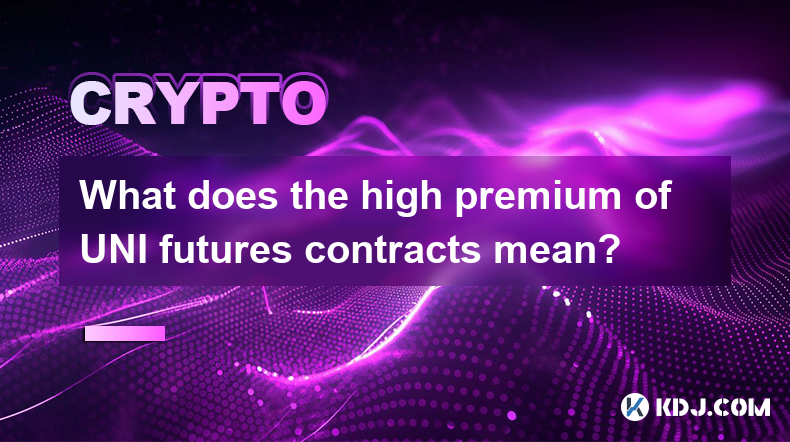
The high premium of UNI futures contracts is a significant indicator within the cryptocurrency market, particularly for those interested in Uniswap's native token, UNI. When futures contracts for UNI trade at a high premium, it suggests a strong bullish sentiment among traders and investors. This phenomenon can be attributed to several factors, including market speculation, anticipated price movements, and the overall demand for UNI in the futures market. Understanding the implications of this high premium is crucial for anyone looking to engage with UNI futures or to gauge the market's sentiment towards Uniswap.
What Are UNI Futures Contracts?
UNI futures contracts are financial derivatives that allow traders to speculate on the future price of Uniswap's UNI token. These contracts obligate the buyer to purchase and the seller to sell a specified amount of UNI at a predetermined price on a future date. Futures contracts are traded on various cryptocurrency exchanges that offer derivatives trading. The premium of a futures contract is the difference between the futures price and the spot price of the underlying asset. A high premium indicates that the futures price is significantly higher than the current market price of UNI.
Why Does a High Premium Occur?
A high premium on UNI futures contracts can occur due to several reasons. Market speculation plays a significant role, as traders might anticipate a future increase in UNI's value. This anticipation can drive up the demand for futures contracts, leading to a higher premium. Additionally, liquidity issues in the futures market can contribute to a high premium. If there are fewer sellers than buyers, the price of the futures contracts can rise. Regulatory news or upcoming events related to Uniswap can also influence the premium, as traders adjust their positions based on potential impacts on UNI's price.
Implications of a High Premium
The presence of a high premium on UNI futures contracts has several implications for traders and investors. Firstly, it signals strong bullish sentiment in the market. Traders who believe that UNI's price will rise in the future are willing to pay a higher price for the futures contracts. This can create a self-fulfilling prophecy, where the increased demand for futures contracts drives up the spot price of UNI. Secondly, a high premium can indicate potential arbitrage opportunities. Traders can buy UNI at the spot price and simultaneously sell futures contracts at a higher price, profiting from the difference.
How to Trade UNI Futures Contracts
Trading UNI futures contracts involves several steps and considerations. Here is a detailed guide on how to engage in this type of trading:
Choose a reputable exchange: Select a cryptocurrency exchange that offers UNI futures trading. Popular exchanges include Binance, Bybit, and FTX. Ensure the exchange is regulated and has a good reputation for security and reliability.
Create an account: Sign up for an account on the chosen exchange. You will need to provide personal information and complete a verification process, which may include submitting identification documents.
Fund your account: Deposit funds into your exchange account. Most exchanges accept deposits in cryptocurrencies like Bitcoin or Ethereum, as well as fiat currencies like USD or EUR.
Navigate to the futures trading section: Once your account is funded, go to the futures trading section of the exchange. Look for the UNI futures contract you wish to trade.
Understand the contract specifications: Before trading, familiarize yourself with the contract specifications, including the contract size, expiration date, and settlement method.
Place your order: Decide whether you want to buy (go long) or sell (go short) UNI futures contracts. Enter the number of contracts you wish to trade and set your desired price. You can place a market order, which executes immediately at the current market price, or a limit order, which executes only at your specified price.
Monitor your position: Keep an eye on your open positions and the market conditions. You may need to adjust your positions based on price movements and other market factors.
Close your position: When you are ready to exit your trade, you can close your position by placing an order to sell (if you went long) or buy (if you went short) the same number of contracts.
Risks Associated with High Premiums
While a high premium on UNI futures contracts can present opportunities, it also comes with significant risks. Leverage is a common feature in futures trading, allowing traders to control large positions with a relatively small amount of capital. However, this can amplify both gains and losses. If the market moves against your position, you could face substantial losses, potentially exceeding your initial investment. Volatility in the cryptocurrency market can also lead to rapid price swings, making it challenging to predict and manage your positions effectively. Additionally, liquidation risk is a concern, as exchanges may automatically close your position if the market moves against you and your account balance falls below the required margin level.
Frequently Asked Questions
Q: Can the high premium on UNI futures contracts be sustained over a long period?
A: The sustainability of a high premium depends on various factors, including market sentiment, liquidity, and external events affecting Uniswap. While a high premium can persist for some time, it is generally not sustainable in the long term without continuous bullish developments.
Q: How does the high premium on UNI futures affect the spot market?
A: A high premium on UNI futures can influence the spot market by increasing demand for UNI tokens. Traders may buy UNI at the spot price to hedge their futures positions, which can drive up the spot price. However, the relationship between futures and spot markets can be complex and influenced by many factors.
Q: Are there any strategies to mitigate the risks associated with trading UNI futures at a high premium?
A: Yes, several strategies can help mitigate risks. These include using stop-loss orders to limit potential losses, diversifying your trading portfolio, and closely monitoring market conditions. Additionally, understanding the fundamentals of Uniswap and staying informed about market news can help you make more informed trading decisions.
Q: How can I determine if the high premium on UNI futures is justified?
A: To determine if the high premium is justified, consider factors such as upcoming events or developments related to Uniswap, overall market sentiment, and historical price movements. Analyzing these factors can help you assess whether the premium reflects genuine market expectations or if it is driven by speculative frenzy.
Disclaimer:info@kdj.com
The information provided is not trading advice. kdj.com does not assume any responsibility for any investments made based on the information provided in this article. Cryptocurrencies are highly volatile and it is highly recommended that you invest with caution after thorough research!
If you believe that the content used on this website infringes your copyright, please contact us immediately (info@kdj.com) and we will delete it promptly.
- Babylon, Bitcoin, and the EVM Mainnet: A New Era for BTCFi?
- 2025-07-07 16:30:11
- Queen Elizabeth Coin Sells for £31,000: A Royal Fortune in Your Pocket?
- 2025-07-07 16:30:11
- Altcoin Season on the Horizon? Michael van de Poppe Eyes a Potential 76% Surge
- 2025-07-07 16:35:12
- Pi Network Price Prediction: Is $1,000 Realistic?
- 2025-07-07 14:30:13
- Cryptocurrency Fraud: Secret Service Issues Warning Amidst Rising Scams
- 2025-07-07 14:30:13
- XRP Price & Bitcoin to $3.4M by 2030? A NYC Perspective
- 2025-07-07 14:50:12
Related knowledge
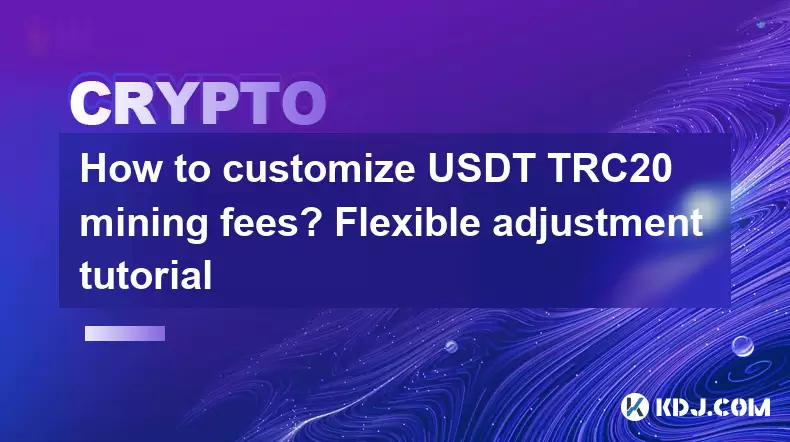
How to customize USDT TRC20 mining fees? Flexible adjustment tutorial
Jun 13,2025 at 01:42am
Understanding USDT TRC20 Mining FeesMining fees on the TRON (TRC20) network are essential for processing transactions. Unlike Bitcoin or Ethereum, where miners directly validate transactions, TRON uses a delegated proof-of-stake (DPoS) mechanism. However, users still need to pay bandwidth and energy fees, which are collectively referred to as 'mining fe...
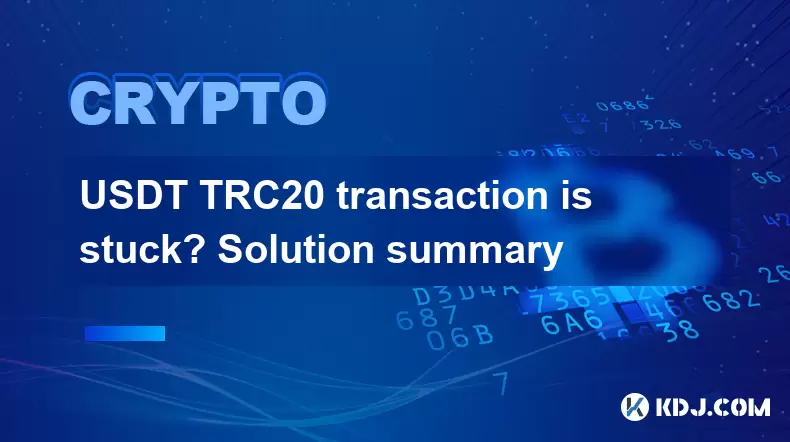
USDT TRC20 transaction is stuck? Solution summary
Jun 14,2025 at 11:15pm
Understanding USDT TRC20 TransactionsWhen users mention that a USDT TRC20 transaction is stuck, they typically refer to a situation where the transfer of Tether (USDT) on the TRON blockchain has not been confirmed for an extended period. This issue may arise due to various reasons such as network congestion, insufficient transaction fees, or wallet-rela...
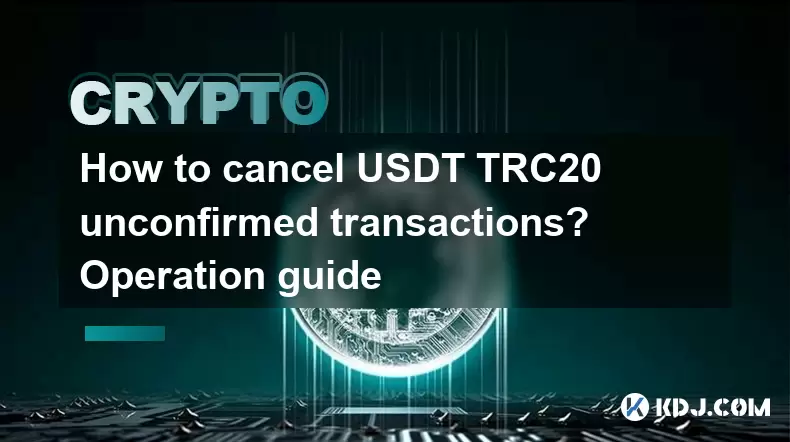
How to cancel USDT TRC20 unconfirmed transactions? Operation guide
Jun 13,2025 at 11:01pm
Understanding USDT TRC20 Unconfirmed TransactionsWhen dealing with USDT TRC20 transactions, it’s crucial to understand what an unconfirmed transaction means. An unconfirmed transaction is one that has been broadcasted to the blockchain network but hasn’t yet been included in a block. This typically occurs due to low transaction fees or network congestio...
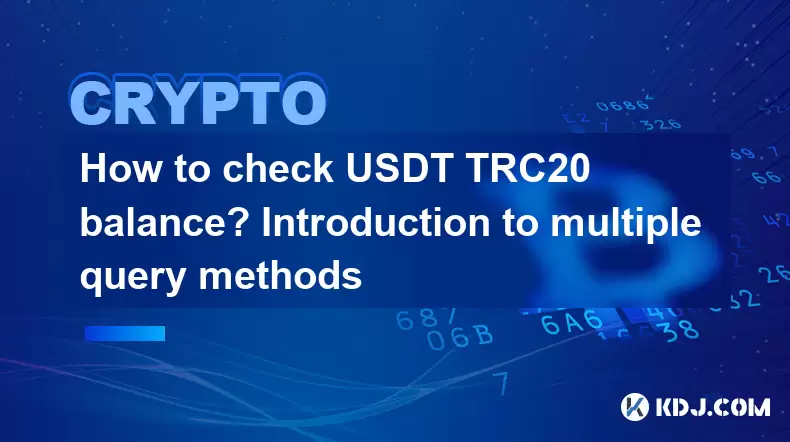
How to check USDT TRC20 balance? Introduction to multiple query methods
Jun 21,2025 at 02:42am
Understanding USDT TRC20 and Its ImportanceUSDT (Tether) is one of the most widely used stablecoins in the cryptocurrency market. It exists on multiple blockchain networks, including TRC20, which operates on the Tron (TRX) network. Checking your USDT TRC20 balance accurately is crucial for users who hold or transact with this asset. Whether you're sendi...
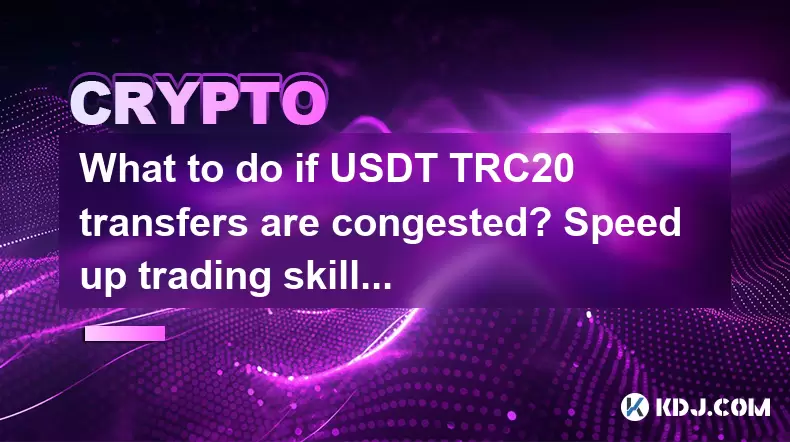
What to do if USDT TRC20 transfers are congested? Speed up trading skills
Jun 13,2025 at 09:56am
Understanding USDT TRC20 Transfer CongestionWhen transferring USDT TRC20, users may occasionally experience delays or congestion. This typically occurs due to network overload on the TRON blockchain, which hosts the TRC20 version of Tether. Unlike the ERC20 variant (which runs on Ethereum), TRC20 transactions are generally faster and cheaper, but during...
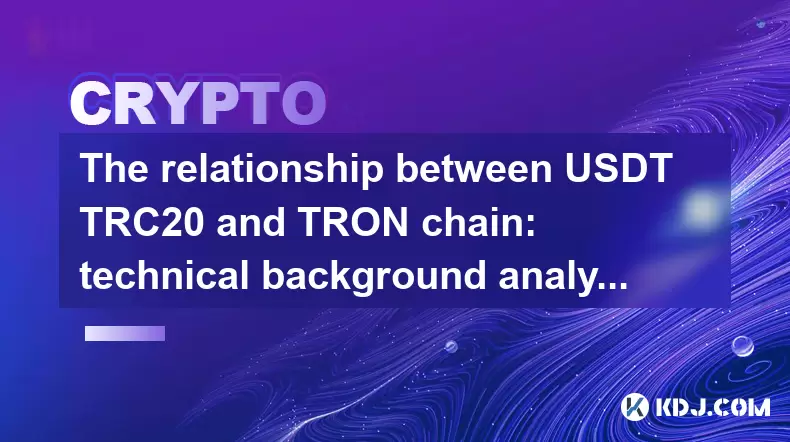
The relationship between USDT TRC20 and TRON chain: technical background analysis
Jun 12,2025 at 01:28pm
What is USDT TRC20?USDT TRC20 refers to the Tether (USDT) token issued on the TRON blockchain using the TRC-20 standard. Unlike the more commonly known ERC-20 version of USDT (which runs on Ethereum), the TRC-20 variant leverages the TRON network's infrastructure for faster and cheaper transactions. The emergence of this version came as part of Tether’s...

How to customize USDT TRC20 mining fees? Flexible adjustment tutorial
Jun 13,2025 at 01:42am
Understanding USDT TRC20 Mining FeesMining fees on the TRON (TRC20) network are essential for processing transactions. Unlike Bitcoin or Ethereum, where miners directly validate transactions, TRON uses a delegated proof-of-stake (DPoS) mechanism. However, users still need to pay bandwidth and energy fees, which are collectively referred to as 'mining fe...

USDT TRC20 transaction is stuck? Solution summary
Jun 14,2025 at 11:15pm
Understanding USDT TRC20 TransactionsWhen users mention that a USDT TRC20 transaction is stuck, they typically refer to a situation where the transfer of Tether (USDT) on the TRON blockchain has not been confirmed for an extended period. This issue may arise due to various reasons such as network congestion, insufficient transaction fees, or wallet-rela...

How to cancel USDT TRC20 unconfirmed transactions? Operation guide
Jun 13,2025 at 11:01pm
Understanding USDT TRC20 Unconfirmed TransactionsWhen dealing with USDT TRC20 transactions, it’s crucial to understand what an unconfirmed transaction means. An unconfirmed transaction is one that has been broadcasted to the blockchain network but hasn’t yet been included in a block. This typically occurs due to low transaction fees or network congestio...

How to check USDT TRC20 balance? Introduction to multiple query methods
Jun 21,2025 at 02:42am
Understanding USDT TRC20 and Its ImportanceUSDT (Tether) is one of the most widely used stablecoins in the cryptocurrency market. It exists on multiple blockchain networks, including TRC20, which operates on the Tron (TRX) network. Checking your USDT TRC20 balance accurately is crucial for users who hold or transact with this asset. Whether you're sendi...

What to do if USDT TRC20 transfers are congested? Speed up trading skills
Jun 13,2025 at 09:56am
Understanding USDT TRC20 Transfer CongestionWhen transferring USDT TRC20, users may occasionally experience delays or congestion. This typically occurs due to network overload on the TRON blockchain, which hosts the TRC20 version of Tether. Unlike the ERC20 variant (which runs on Ethereum), TRC20 transactions are generally faster and cheaper, but during...

The relationship between USDT TRC20 and TRON chain: technical background analysis
Jun 12,2025 at 01:28pm
What is USDT TRC20?USDT TRC20 refers to the Tether (USDT) token issued on the TRON blockchain using the TRC-20 standard. Unlike the more commonly known ERC-20 version of USDT (which runs on Ethereum), the TRC-20 variant leverages the TRON network's infrastructure for faster and cheaper transactions. The emergence of this version came as part of Tether’s...
See all articles





















